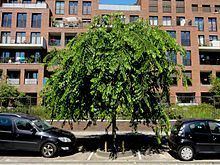Cultivar 'Cathedral' | ||
 | ||
Hybrid parentage U. davidiana var. japonica × U. pumila Similar Ulmus parvifolia 'King's Ch, Ulmus 'Recerta', Ulmus minor 'Purpurascens', Ulmus minor 'Propendens', Ulmus minor 'Schuurhoek' | ||
Ulmus 'Cathedral' is a hybrid cultivar raised at University of Wisconsin–Madison (no. W44-25) from seed derived from the openly-pollinated crossing of Japanese Elm (female parent) with Siberian Elm at the Botanical Garden, Hokkaido University, Sapporo, and thus a sibling of 'Sapporo Autumn Gold'. 'Cathedral' was patented in 1994.
Contents
Description
The tree is distinguished by its weeping form and large elliptic leaves, < 14 cm long by < 8 cm broad, almost the same size and shape of those of its female parent, the Japanese Elm, spinach green when mature, turning yellow and orange in autumn. [2]
Pests and diseases
Tests in the USA have found 'Cathedral' to be less resistant to Dutch elm disease than its WARF stablemates such as 'New Horizon', although damage is usually confined to the branch tips. Studies in France by the Institut National de la Recherche Agronomique (INRA) confirmed the tree as only 'moderately resistant'. The leaves are also favoured by leaf hoppers and other insects that feed by piercing and sucking.
Cultivation
The tree requires relatively high levels of maintenance owing to its predilection for breaks occasioned by branch inclusions. 'Cathedral' is widely available across the United States, and has also been commercially released in Europe.
Etymology
The tree was named by Mr Donald Willeke of Minneapolis, who observed that where planted in tight rows, a series of gothic cathedral-like arches was ultimately created between the trees.
